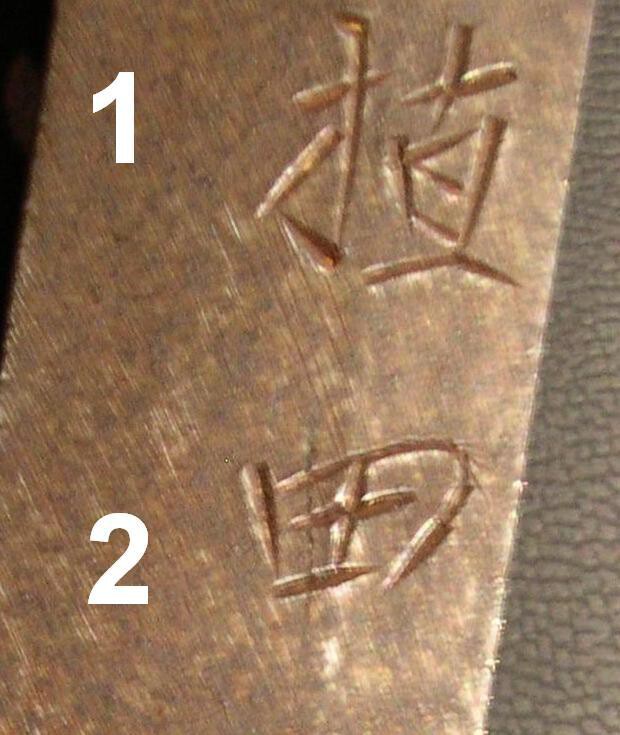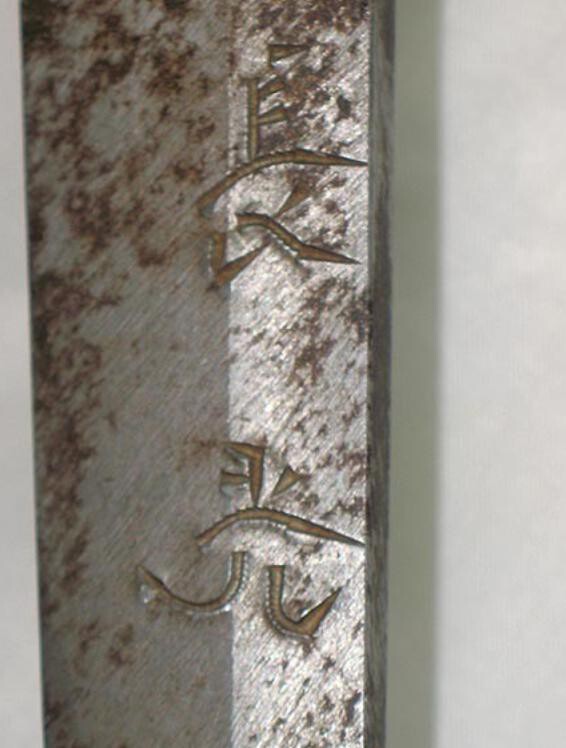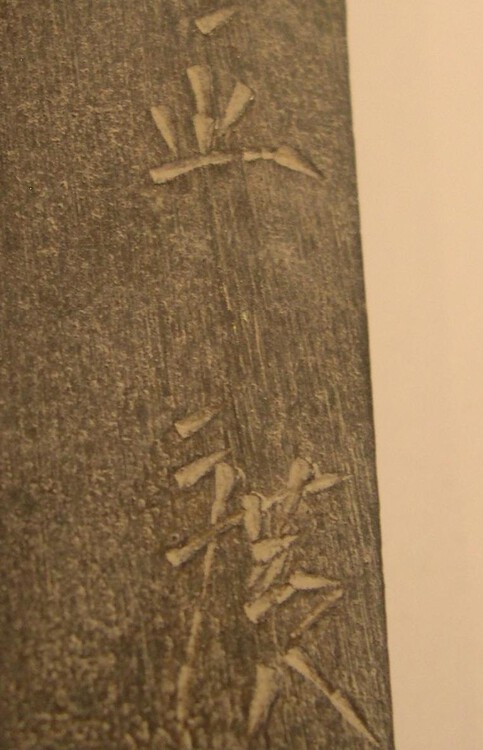-
Posts
64 -
Joined
-
Last visited
Content Type
Profiles
Forums
Events
Store
Downloads
Gallery
Everything posted by JamesH
-
Hi all, Im not sure if this thread belongs in this section of the forum, Brian please feel free to move as you see fit. I wanted to find out whether KUSARIGAMA are considered nihonto, that is, whether they carry the same characteristics of hada, hamon etc. If so, does anyone have pics of one in mint traditional polish? With thanks, James
-
Keith, Thank you, very interesting indeed. Please keep us posted if you get any news or pics! of the sword :D James
-
Hi all, I am not sure if no one noticed this, or if there is something about it I am simply not seeing: http://cgi.ebay.com.au/ws/eBayISAPI.dll ... K:MEWAX:IT To my newbie eyes, looks quite healthy. Although unsigned, I like the way the nakago is finished, patina looks undisturbed. Had I not blown my budget late November, I would have snatched it up quick. Your thoughts are greatly appreciated, especially if there is something I am not seeing. James P.S. Before you ask, no I am not affiliated with the seller in any way shape or form, just trying to benefit my own understanding.
-
Keith, Thank you kindly for sharing. Yes I think indeed your experience may be as close as we may come to identifying what a shinobi nihonto may, and again may not look like. Much is as I expected, in regards to the slightly shorter nagasa with a deeper sori for a quicker draw. You mentioned the blade ha rough nakago, I was hoping you could elaborate... Do you mean that it did not look well finished, or just aged poorly? I was also intrigued with the fact that dating the sword back to momoyama, you did not find any kizu. I am guessing it was a very well made, whereas I thought a shinobi katana may bear a slight resemblence to satsuma, in terms of quality. Perhaps they had a dedicated smiths? Thanks again for sharing. James
-
I think it is cast as I do not see any evidence of strokes in the mei, I think the signature is actually part of the mold. Also, I think the more expensive tsuba is an iron cast copy, while the other is mentioned to be copper. I doubt either are modern copies, I think both are showa or older, but certainly not the real thing. Someone once told me that the most famous tosogu themes/pieces were printed or copied into catalogues, available to other tosogu makers, hence why often you will see different workmanship on identically themed pieces. Just my 2 cents. James
-
Thank you for all your responses. I had a look at the ninja forum, but it seems it is all about function, not so much on tradition. From what little I know, and can imagine, the ninja were assassins who did the dirty work. As their honor was never at stake, they could attack and kill a samurai, in situations when it would be considered dishonorable for another samurai to do so. I have always felt a bit of a hole in my collection where a working shinobi blade would go. I can only imagine the number of contraptions they may have had to do what they needed to do, I guess I wanted to know if there were tactical attributes like the ones on the cheness blade, that a ninja blade would demand of a tosho at the time... after all nihonto adapted as Japanese society and external threats to it changed, so why would this be an exception. Personally, I have my doubts about tosogu with shinobi links, as given the mystery and secrecy of the ninja clans, I doubt one would risk to be given away by a tsuba on his sword. I will try to track down a copy of 'The Ninja Sword' by Katsumi Toda (1986), perhaps it will shed some light on this mystery. James
-
Hi Piers, Thanks for your response. Good to know my kanji reading is improving at least a little James
-
Hi, I am having trouble translating this mei. I think the second character is Da and the third is Kane ... am I even close? Any assistance is greatly appreciated. James
-
Hi everyone, I am not sure if this has already been addressed on this board, but for my own benefit I was hoping to find out the truth about shinobi clans, and if possible dissapate the myth of the 'Hollywood Ninja' sword. I came across this from http://www.chenessinc.com/9260oniyuri.htm : I know this will probably seem laughable to many of the more experienced member, but as I novice ... if I don't ask, I wont know :D Is there ANY truth to the above? Was there any particular characteristics to swords used by shinobi? James
-
Wow US $1,036.00 ... I guess someone really took a liking to it. After having a closer look at the shape, I must agree with others than it looks like a 1944 gunto blade. One thing that still gets me though, I have never seen a katana shortened into a wakizashi in this way. Shouldn't the nakago have been shortened? Having studied some martial arts and swung a few blade I wonder, wouldn't this upset the balance of the blade? James
-
It hurts to think that the pieces of history we spend so much time, effort and often money to preserve, could one day come across (if they haven't already) someone who would abuse them in such a way. Louis, if I may, I was hoping you could elaborate on the process of nugui and exactly what is supposed to happen, in a strictly TRADITIONAL method of this process. I have never quite understood how the non-abrasive [please correct me if I am wrong] rubbing iron oxide enhances the ji-hada. Thanks in advance, James
-
I came across this on flea bay, and was hoping someone could propose how such an unnatural looking (shape) nakago could have come about: http://cgi.ebay.com/E040-REAL-Japanese- ... 43a3b71318 will not mention the odd looking rust. James
-
I have seen a koa isshin wakizashi in shirasaya, but someone snatched it up well before I was able to buy ... it all comes down to $$ James
-
Jamie, When I mentioned that are few of the final traditional polishing processes are chemical, I did not mean that chemicals were added, although nugui does in part consist of iron oxide. I cannot remember where I exactly I read it, but the whitening of the hamon during the hadori stage is not only due to very very fine 'polishing/scratching' by the hazuya stone, but also due to a chemical reaction which occurs when the uchigomori particles rub against each other and the steel.... I am not a togishi, and cannot say any of these things for certain, which is why I was hoping some of the more knowledgeable members may clear up the mist. Also with nugui, I am quite sure the darkening/blueish hue achieved is also achieved by a chemical reaction between iron oxide (+ the other ingredients) and the steel. Again perhaps a togishi might clarify exactly what happens here. James
-
The use of acid by togishi was briefly discussed a few months back with an example of a nihonto where ji-hada was brought up by acid, and then after a professional polish. The pics of the blade worked over by acid, showed obvious unnatural looking ji with excessive but bland ji-hada showing... something I did not notice on this blade. I could not find the thread for the life of me, but I also remember a quote that "many professional togishi use mild acids during the polishing process, however when it is done by a highly-skilled professional, you would never suspect that any form of acid has been used." To my knowledge, a few processes in the traditional final polishing stages are partially chemical, such as jizhuya and nugui, but I was hoping someone could elaborate on this. James
-
Hi all, I am not sure if these questions have been asked previously, but I thought I may ask anyway: 1. Is the title O-wazamono (extremely sharp) an attribute of the blade or simply polish (shape/sharpening by the togishi) it is in? To clarify... Can any blade be made this sharp or are there specific attributes to the steel/hamon/hada that are prerequisite? 2. How and by whom is this title given (shinsa / tosho / or the last togishi who worked on the blade)? Please be gentle, if this comes off as a newb question , but... if you don't ask you'll never know ! :D James
-
Today I came across this .... (see image below). Now I am not sure if I am just paranoid (become so after looking into the topic of gimei gendaito :lol: ), but does this mei seem a little off to anyone else. For comparison, I have included a link to a recent auction for a Nagamitsu I followed (okay bid and lost ). I think the seller is a member: http://cgi.ebay.com/Japanese-WW-II-Army ... 4aa5b53d87 Now the second example, even though the nakago is in a slightly worse state, raises no questions in my mind. Any thoughts..? Regards, James
-
Chris, For quite a while, I was also under the impression that gendaito were a pretty safe bet in terms of not being gimei. Unfortunately, I have not been so lucky as to see for myself a gimei Yasunori (so I could compare to a genuine one), and as I mentioned the Nagamitsu which throw doubt could be explained by the fact that many are daimei, and most likely only a handful (if that) were made from start to finish by Ichihara himself. What did pop up in my mind though ... The majority of Nagamitsu I came across had a strong and confident mei, and in my eyes the particular style of kanji is very pronounced and hard to confuse with another smith, even if you cannot immediately translate. In saying this, I do not limit this to traditionally forged gendaito, but also a few honest showato I have seen proudly bearing only 2 kanji (Naga Mitsu). The ones that raised questions, looked traditionally forged (folded showing jihada, water-tempered hamon), but the nakago had all the signs of a gimei - weak yasuri, shallow carved kanji often looking 2 or 3 strokes/hammers short of how Nagamitsu or one of his students would carve it. Also, on one occasion kanji seemed slightly too small and out of place, almost as someone was drunk and couldn't carve in a straight line. lol Basically, had this been any other era I would call gimei, but as per the above preconception of gendaito being a safe bet, I thought it was most likely just not a good example and simply moved on. As mentioned on this forum time and time again - each sword should be judged on its own merits (or lack of). Chris, David could you share your experiences? What gave away that it was not the real thing? It would be good to stay with Showa Era, as newer swords such as shinsakuto are a whole different animal in my opinion. Regards, James
-
Hi everyone, While I know that gimei signatures existed almost as long as nihonto have, but I have not come across any copying Showa Era smiths. I have seen a few showato bearing a gimei signature of famous smiths, and a few wearing names which sounded made up (I couldn't find any info on them either). One was signed Muramasa, but with all the trademarks of a Showa Era showato, mounted in so-so late war gunto mounts. From what I have been told, it was regarded as honourable to carry a sword bearing a famous name into battle - even if it was not genuinely made by that particular smith. Is this true? I guess what I am leading up to ... Has anyone come across a gimei of a famous Showa Era smith such Horii Toshihide or Takahashi Sadatsugu? I have seen a few iffy signatures by Nagamitsu, but I assumed that since he had a factory may be they were signed by his workers/apprentices. Also, in a couple of those cases the hamon looked a little out of his style. Any and all input is greatly appreciated. Regards, James
-
Thank you Morita-san. Once again your knowledge and experience are absolutely invaluable. Would you be able to post the other two oshigata as well? With thanks, James
-
Hi all, I was wondering if anyone had an oshigata or an image of a mei by Takano Masakane. I am not sure, I think they may be one in Hawleys, but I still have not managed to track down a copy for myself. Google turned up empty, and my John Sloughs seems to be missing it. Thanks in advance for your help. James
-
Thank you both so much!! Now that you said it, it seems so obvious. Meanwhile in my lonely efforts, the first kanji looked like (image below) - no wonder I could not find it. Many many thanks, James
-
Hi everyone, I was wondering if anyone could help me with this mei. I have been back and forth through the books as well as kanji pages, and cannot find either of the 2 kanji. If anyone could translate, or point me in the right direction, it would be greatly appreciated. James
-
Hi everyone, I apologise for starting a topic and not quite being present, we've just had the Queen's birthday long weekend here, and I decided to take the family for a short holiday up to the central coast. Firstly, I would like to sincerely thank Chris and Tsugio Kawakami for correcting my terminology. I am still getting familiar with all the correct terms for what I am attempting to express, and if no one corrects me I will NEVER learn Also a big thanks to thank John, Peter and Jamie for posting the pictures. It is true a picture is worth a thousand words. I do have another question though... In all the examples where core steel is showing, I notice it is generally highlighted by a darker colour/color. I understand that in the majority of cases it sits below the surface of the blade, and so if it rusts the rust is only cleaned off if it is covered by horimono, but pics from Jamies link show (and it could just be my eyes) that it sits on the same level, and still has a rusty tint to it, while the remained of the blade is virtually in full polish. Is core steel more volatile to oxidation or is it a darker colour/color steel? Thank you all again, James









